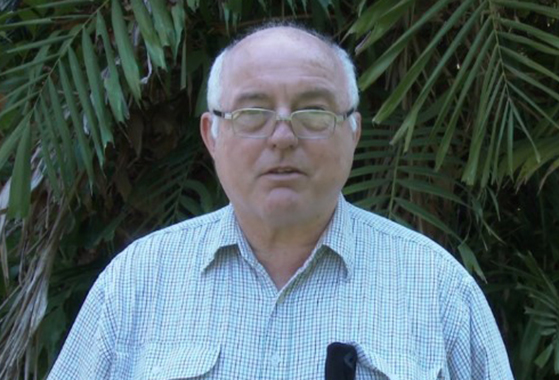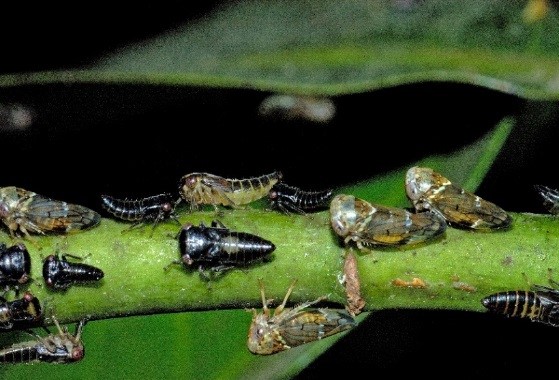DPIR releases new mango leafhopper vs planthopper video
Planthoppers, leafhoppers, flatids….. If you are confused about these mango pests then you’re not alone. Many mango growers struggle to tell the difference between the mango planthopper and the mango leafhopper. To help, the Department of Primary Industry and Resources (DPIR) entomology branch have released a new video talking through the differences and how to identify them in your orchard.
Principal entomologist Brian Thistleton discusses the differences between leafhoppers and planthoppers in the new video (left), Mango leafhopper on a flower panicle (middle), Mango planthopper (right)
As mango flowering season shifts into full gear, it is especially important for growers to monitor for pests in their orchard. Two important sap sucking insects on mango are mango leafhoppers and mango planthoppers, also known as flatids. These two groups of insects are quite distinct in appearance and the damage that they cause. Mango leafhoppers, Idioscopus nitidulus are small cicada like insects which are most important at flowering, while mango planthoppers, Colgaroides acuminate are green or whitish-green in colour, hold their wings in a tent-like shape when at rest and suck sap from the shoots, flowers and fruit.
Mango leafhoppers breed all year round but produce more eggs during the flowering and fruiting period. The nymphs also develop faster during this period. Eggs hatch in 2-3 days and the development period from nymphs to adults is 12-20 days.
Leafhoppers are sap suckers. Feeding and egg laying causes curling and distortion of new flush and damage to flowers. On closer examination, eggs can be seen inserted into the mid rib of the leaves and flower panicles. Leafhoppers excrete a sticky liquid known as honeydew which promotes the growth of black sooty mould. Sooty mould interferes with photosynthesis which reduces the vigour of the tree and as a result there is a decrease in yield. Sooty mould can also be caused by other common pests such as flatid planthoppers, pink wax scale, and mealybugs. When left untreated, which is often the case in home gardens or derelict mango orchards, numbers of leafhoppers build up rapidly to the extent where leaves and flowers are damaged and there is little fruit production.
Mango leafhopper populations generally increase from March onwards and this is the crucial time for growers to commence regular monitoring. Since mango leafhopper populations are able to build up very rapidly they should be treated as soon as they are detected. Regular monitoring will enable growers to detect early infestations and treat the affected trees rather than having to treat the whole orchard after they have spread.
The mango planthopper, Colgaroides acuminata as well as other planthoppers such as Siphanta, often referred to as “flatids” are pests of mangoes and other tree crops. Feeding damage is seen on the fruit stalk and skin of the fruit. Regular insect monitoring is important in the detection of this pest and treatment should be carried out before the pest reaches damaging levels.
Adults and nymphs suck sap from the shoots, flowers and fruit. Planthoppers are often seen on the fruit stalk or leaves and their feeding on the fruit stalk may cause sap to flow onto the fruit, causing sapburn.
Planthoppers excrete honeydew and an infestation will generally be indicated by the presence of sooty mould which grows on the honeydew. The presence of sooty mould may also be due to an infestation of mango leafhopper or other sap feeding insects.
The new video on mango leafhoppers and planthoppers forms part of the Growing Tips series, found on our YouTube channel. The Growing Tips channel is a series of short (five minutes or so) how to videos on a range of subjects from mango dry matters to date pollination.
For information on insect pests you can visit the NT insects database, or flip through our field guide to pests, beneficials, diseases and disorders or mangoes.
To speak to someone about management strategies, contact the entomology branch on (08) 8999 2258, or email them at insectinfo@nt.gov.au.
Give feedback about this page.
Share this page:
URL copied!


